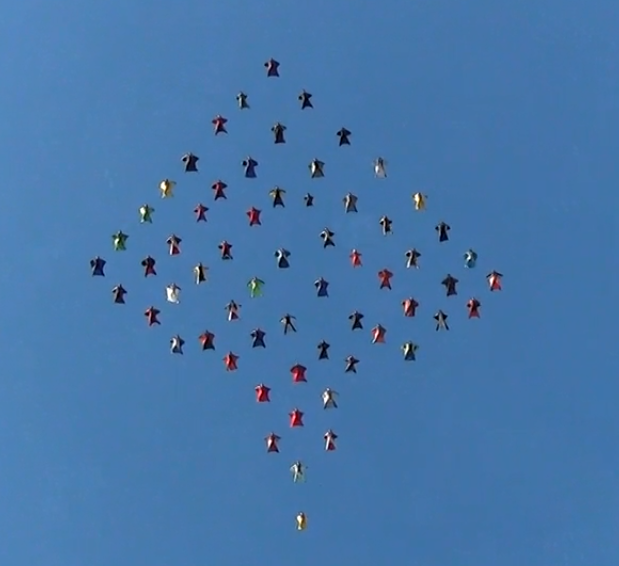ozzy13 0
Quote>Again 45% on fatalities were from people with 2000 plus jumps killing themselves.
>So all these charts would not helped any of them.
Nope - but the education required to progress would. Education works - and restrictions that are in place until you get that education help people get it.
Actually are you sure about that? You know that all of them have not taken canopy courses. If not neither your restrictions or the new canopy courses for B would of helped them. There is no way of knowing if what we will put in place would of help the past. We cant get any real data on what is the real problem. We need to know everyone's history to do this. For someone to say this would of help them is just talking out your ass. (Im not saying you per say)Im sorry. We see a problem and everyone has there opinion on how it can be fixed. No one has showed me anything that will support their idea in fixing the problems we are having in this area of our sport.
I do see a deficiency in our progression. One big one is the only canopy education you needed was on your A card. Bare minimum if you ask me. So we are moving in the right direction at least. Will it help? Not sure. Again no numbers to go by. I do think it will eventually make it a safer sky in the future.
the sky's pretty safe already, it's the ground that isnt! ![]()
-Hunter S. Thompson
"No. Try not. Do... or do not. There is no try."
-Yoda
kallend 1,621
QuoteQuoteQuoteI agree with some of what you are saying. It is why I keep saying how is these charts going to help these guys from turning themselves into the ground. Everyone of them had 2000+ jumps.
.
WELL, in post #2 of this thread I asked:
"Do you have any data on how many accidents (fatalities, since that's what we know about) occurred in each of these experience levels in the past, say, 3 years, and what % or those involved jumpers violating the proposed limits? "
No answer received.
Before imposing any rules on the community, the proposers need to make a very clear analysis of the scope of the problem and the likely impact of the proposed "solution". That has not been done.
Dude i didnt answer the first time and wont answer this time. Do the work yourself if you want to know such data. I looked and 45% were low turns with jumps over 2000. There is not much more info then that. So I dont know. Im not proposing anything so dont need to do the work. I dont think we should use a chart as a restriction.
I wasn't asking YOU to do any work - heaven forbid such a thing.
There is a burden on people who want to impose new restrictions on the rest of us to justify them. The proposers of the various WL BSRs need to do their homework. They haven't.
The only sure way to survive a canopy collision is not to have one.
QuoteIf someone is willing to put the time and energy into really learning to fly their canopy, we should reward that with letting them fly a canopy more suited to what they perceive as the best canopy for them.
The question is, what are they basing that perception on? I can base my perception of how different canopies fly on my experience flying them, and seeing the differences. Unless you've flown 'them all', you can't really say which ones are, or aren't, good for you. You could guess, but if you guess wrong, the consequences can be dire.
So even if someone has education, their ability to handle a canopy remains unknown until they try it. So the best method to dealing with this is to ensure that jumpers start at an appropriate level, and move one step at a time while taking an appropriate level of time at each step.
Without the steps, and some sort of requirement for time on each step, you could have jumpers making 5 or 10 jumps on one size before downsizing. In my book, that hardly 'proves' their ability to handle that size, and certainly doesn't allow them sufficient time to truely acclimate to the new canopy.
ozzy13 0
QuoteI was not jumping in crazy winds, but still had a few elevator rides and a bunch of extra turbulence that no one else felt. And that was on my high performance Sabre1 150 at .9 wingloading (for about 250 jumps).
Just to be fair, as per B Germains WL chart, by 250 jumps you could have been on a 135 (at 1.0) or even a 120 (at 1.1).
Beyond that, you have to understand that you are far off the 'norm' in skydiving. When making rules/regulations/laws, you make them to apply to the largest segment of the population, that being the 'average', the middle of the bell curve. Even if people on the ends of that curve aren't perfectly served, you need to govern for the good of the many, not the few.
Do you really feel as if a 135 or a 120 would have been overly restrictive? The truth is, you might have had it better than bigger jumpers who might have been able to go 0.1 higher in WL, but would have still been on a 150 or larger. You might have ended up with a more responsive canopy by going with the smaller wing, even at a slightly lower WL.
Beyond that, .09 WL isn't rediculously low, and certainly isn't something that any manufacturer would consider 'unsafe' or 'under-loaded' for any of their canopies (HP models aside).
becka 0
QuoteQuoteI was not jumping in crazy winds, but still had a few elevator rides and a bunch of extra turbulence that no one else felt. And that was on my high performance Sabre1 150 at .9 wingloading (for about 250 jumps).
Just to be fair, as per B Germains WL chart, by 250 jumps you could have been on a 135 (at 1.0) or even a 120 (at 1.1).
Yes, but according to this proposal, I couldn't have even been on the 150 until I had 100 jumps and done things including front riser maneuvers that would have been difficult or maybe impossible for me.
And according to the SIM, I shouldn't have been on that canopy until 500 jumps.
QuoteBeyond that, you have to understand that you are far off the 'norm' in skydiving. When making rules/regulations/laws, you make them to apply to the largest segment of the population, that being the 'average', the middle of the bell curve. Even if people on the ends of that curve aren't perfectly served, you need to govern for the good of the many, not the few.
While I am small, there are many skydivers that are smaller (to the tune of 10 - 30 lbs) than me and I think this warrants the extra column or two to the left and some consideration on the skill set required to downsize.
And it's not like it's that hard to do that. There is no damage to the larger jumpers to put the appropriate restrictions on smaller jumpers. To say the smaller jumpers are out of luck because there are more bigger jumpers is just silly.
QuoteDo you really feel as if a 135 or a 120 would have been overly restrictive? The truth is, you might have had it better than bigger jumpers who might have been able to go 0.1 higher in WL, but would have still been on a 150 or larger. You might have ended up with a more responsive canopy by going with the smaller wing, even at a slightly lower WL.
Beyond that, .09 WL isn't rediculously low, and certainly isn't something that any manufacturer would consider 'unsafe' or 'under-loaded' for any of their canopies (HP models aside).
You are right that a 150 usually wasn't that bad for me at .9, though the switch to the 135 and later the 119 was definitely appreciated. I do not believe at my size those two sizes are that restrictive...it's a matter of getting there and that is what concerns me about this proposal.
I would not go as far as to say that it was that more responsive than what a larger jumper would be on at a higher wingloading, it wasn't that responsive unless we are talking about detecting turbulence. I'm not complaining about a difference .1 in wingloading vs a larger jumper though. It's the much more dramatic differences in allowable wingloading (and lack of taking that into account on the skills required to download).
QuoteQuoteQuoteQuoteI agree with some of what you are saying. It is why I keep saying how is these charts going to help these guys from turning themselves into the ground. Everyone of them had 2000+ jumps.
.
WELL, in post #2 of this thread I asked:
"Do you have any data on how many accidents (fatalities, since that's what we know about) occurred in each of these experience levels in the past, say, 3 years, and what % or those involved jumpers violating the proposed limits? "
No answer received.
Before imposing any rules on the community, the proposers need to make a very clear analysis of the scope of the problem and the likely impact of the proposed "solution". That has not been done.
Imposing rules without research is SOP these days, Perfesser. Please don't further confuse these peeps by asking them to apply something as quaintly archaic as scientific method to their musings.
44
LOL confuse such folks lol ok high and mighty. This website is a joke. One more week and you wont see me until i get bored next winter. So flame on!!! I took your comment as a insult. I am the only one that has shown any kind of stat in all of these proposal WL threads. Again 45% on fatalities were from people with 2000 plus jumps killing themselves. So all these charts would not helped any of them There are three or four of them on this site right now. Your so smart show me different.
No insult intended. especially since you say you do NOT support the charting process being discussed. My point is simply that there's a lot of blah-blah without any kind of research. Yours is limited only to fatalities, and in fact, I totally agree with you: This whole discussion is pretty silly because the majority of the action taking place these days happens to people who are far beyond the reach of the proposed restrictions.
That is why I keep beating the basic aerodynamics horse and the private-pilot-level ground school horse: If you don't get them dialed into the fundamentals of flight -- ANY kind of flight -- early on, then no amount of bandaids in the form of the proposed charts and restictions is going to change anything. So if I understand your last post correctly, we be on the same page, so chill, my brothuh from anothuh mothuh.
44
"The beginning of wisdom is to first call things by their right names."
ozzy13 0
QuoteQuoteQuoteQuoteQuoteI agree with some of what you are saying. It is why I keep saying how is these charts going to help these guys from turning themselves into the ground. Everyone of them had 2000+ jumps.
.
WELL, in post #2 of this thread I asked:
"Do you have any data on how many accidents (fatalities, since that's what we know about) occurred in each of these experience levels in the past, say, 3 years, and what % or those involved jumpers violating the proposed limits? "
No answer received.
Before imposing any rules on the community, the proposers need to make a very clear analysis of the scope of the problem and the likely impact of the proposed "solution". That has not been done.
Imposing rules without research is SOP these days, Perfesser. Please don't further confuse these peeps by asking them to apply something as quaintly archaic as scientific method to their musings.
44
LOL confuse such folks lol ok high and mighty. This website is a joke. One more week and you wont see me until i get bored next winter. So flame on!!! I took your comment as a insult. I am the only one that has shown any kind of stat in all of these proposal WL threads. Again 45% on fatalities were from people with 2000 plus jumps killing themselves. So all these charts would not helped any of them There are three or four of them on this site right now. Your so smart show me different.
No insult intended. especially since you say you do NOT support the charting process being discussed. My point is simply that there's a lot of blah-blah without any kind of research. Yours is limited only to fatalities, and in fact, I totally agree with you: This whole discussion is pretty silly because the majority of the action taking place these days happens to people who are far beyond the reach of the proposed restrictions.
That is why I keep beating the basic aerodynamics horse and the private-pilot-level ground school horse: If you don't get them dialed into the fundamentals of flight -- ANY kind of flight -- early on, then no amount of bandaids in the form of the proposed charts and restictions is going to change anything. So if I understand your last post correctly, we be on the same page, so chill, my brothuh from anothuh mothuh.
44
Trust me I find this website entertaining more so then anything else. Don't get me wrong there is some good info here but most people posting have their own agenda behind their posts. This whole typic is being discussed in three threads. Anyway I'm chill just took your comment like it was directed at me. I'm far from that. Piece.
Quotebut most people posting have their own agenda behind their posts.
And that would include you. What is your agenda?
Sparky
ozzy13 0
QuoteQuotebut most people posting have their own agenda behind their posts.
And that would include you. What is your agenda?
Sparky
Glad you asked. I don't want added regulation placed on my sport cause someone thinks they no best. Show where any of these propose chart would of helped or changed any of the canopy incidents. Just to assume that it will help change what's going on is stupid. Give me data showing it. If that can be done I would support it. Until then I'm againest any more regulations. Now you know
jayrech 0
Be careful what you say. Some one might take it the right way.
ctrph8 0
QuoteQuoteIf someone is willing to put the time and energy into really learning to fly their canopy, we should reward that with letting them fly a canopy more suited to what they perceive as the best canopy for them.
The question is, what are they basing that perception on? I can base my perception of how different canopies fly on my experience flying them, and seeing the differences. Unless you've flown 'them all', you can't really say which ones are, or aren't, good for you. You could guess, but if you guess wrong, the consequences can be dire.
So even if someone has education, their ability to handle a canopy remains unknown until they try it. So the best method to dealing with this is to ensure that jumpers start at an appropriate level, and move one step at a time while taking an appropriate level of time at each step.
Without the steps, and some sort of requirement for time on each step, you could have jumpers making 5 or 10 jumps on one size before downsizing. In my book, that hardly 'proves' their ability to handle that size, and certainly doesn't allow them sufficient time to truely acclimate to the new canopy.
I think the key here is that they will have done the work first and then have the option to downsize. It might even be more than one size down too. If a guy my size went from a 230 down to a 190 it might (or might not) be a bit of a stretch but not unreasonable. I just think if someone is willing to go through the training and demonstrate a proficiency with the concepts AND execution of it, that should count for something towards being able to choose the canopy that is right for them.
Also, every one of us who tried a smaller/different canopy has had a time in their lives when they had not tried that canopy. The remedy for that is actually getting out there, trying things and learning. I only speak for myself here but I've tried lots of canopies and purchased many fewer.
Jump numbers alone are not the answer. Education and demonstration of that knowledge is the answer. We all know a version of "that guy" who has a ton of jumps and no clue.
I still hold that if someone can show that they have mastered the skill set, they should be rewarded for their work with the freedom to make a wider set of choices for themselves.


.thumb.jpg.4bb795e2eaf21b8b300039a5e1ec7f92.jpg)





>So all these charts would not helped any of them.
Nope - but the education required to progress would. Education works - and restrictions that are in place until you get that education help people get it.
Share this post
Link to post
Share on other sites